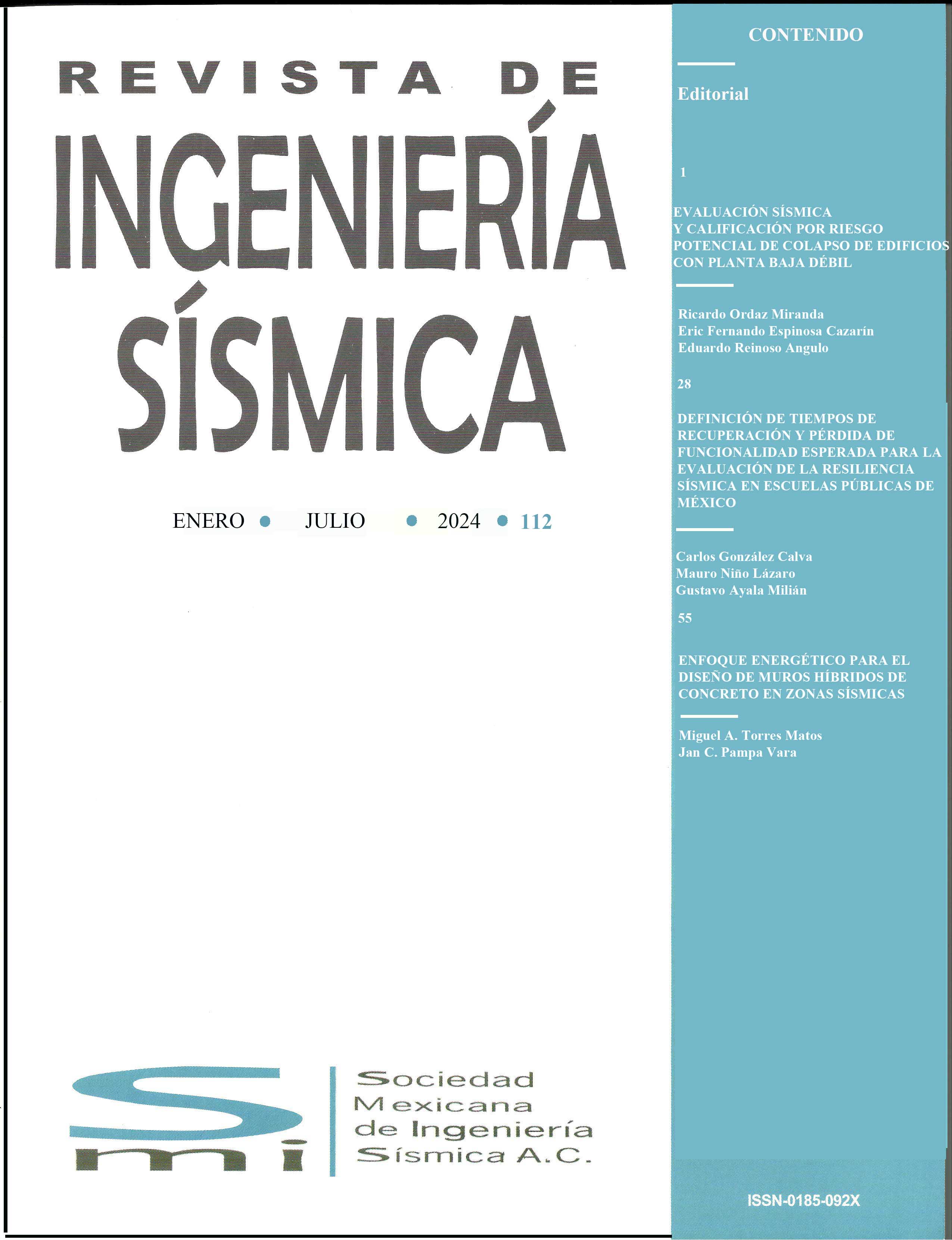CONFIABILIDAD SÍSMICA DE PLATAFORMAS MARINAS CON DAÑO POR FATIGA PARA LA ELABORACIÓN DE PLANES DE INSPECCIÓN BASADOS EN RIESGO
DOI:
https://doi.org/10.18867/ris.77.93Resumen
En este trabajo se propone un método para estimar la probabilidad de falla global de plataformas marinas con daño acumulado por fatiga sometidas a cargas sísmicas. Se discute la variación de la confiabilidad estructural de una plataforma marina con el tiempo y se presenta el modelo para la evaluación de la confiabilidad de las juntas sometidas a daño acumulado por fatiga. Se propone una función de estado límite expresada en términos del cortante basal resistente del jacket y el actuante debido a excitaciones sísmicas. La probabilidad anual de falla de la plataforma, condicional a un estado de daño por fatiga en las juntas, se estima mediante simulación de Monte Carlo. Se utiliza un modelo de riesgo, expresado en términos de costos esperados de inspección, reparación y falla, para la selección de planes óptimos de inspección estructural. Se ilustra su aplicación en el diseño de planes de inspección para extender la vida de servicio de plataformas marinas.
Descargas
Citas
API RP-2A (1993), Recommended practice for planning, designing and constructing fixed offshore platforms, American Petroleum Institute, 20aedición.
Bea, R (1992), “Seismic design and requalification methodologies for offshore platforms”, Proceedings of the International Workshop on Seismic Design and Reassessment of Offshore Structures, California Institute of Technology.
Bea, R (1997), “Risk based oceanographic and earthquake criteria for design and requalification of platforms in the Bay of Campeche”, Reporte a Petróleos Mexicanos, Instituto Mexicano del Petróleo y Brown and Root International Inc., Ocean Engineering Services, Moraga California.
Bhattacharya, B, R Basu y K Ma (2001), “Developing target reliability for novel structures: the case of the Mobile Offshore Base”, Marine Structures, Vol. 14, pp.37-58.
Chávez, M (1997), “Seismic hazard and design spectra for Sourthern Gulf of Mexico”, 16th International Conference on Offshore Mechanics and Artic Engineering, Proceedings of Earthquake Criteria Workshop: Recent Developments in Seismic Hazard and Risk Assessments for Port, Harbor, and Offshore Structures, Yokohama, Japón, Abril 17, ASME, New York, N.Y.
CIRIA (1977). “Rationalisation of safety and serviceability factors in structural codes”. Reporte 63, London: CIRIA (Construction Industry Research and Information Association).
Enevoldsen I y J D Sørensen (1994), “Reliability-based optimization in structural engineering”, Structural Safety, Vo.15, pp. 169-96.
Faber M H, S Engelund, J D Sørensen y A Bloch (2000). “Simplified and generic risk based inspection planning”. Proceedings of the 19th Offshore Mechanics and Arctic Engineering Conference, New Orleans.
Faulkner, D (1983). “On selecting a target reliability for deep water tension leg platforms”. Proceedings of the 11th IFIP Conference on System Modelling and Optimization. Copenhagen: IFIP.
Flint, A K (1976). “Design objectives for offshore structures in relation to social criteria”. Proceedings of the BOSS Conference Trondheim: Tapir.
Heredia, E y R Montes (2004). “A bayesian model for the probability distribution of fatigue damage in tubular joints”, Journal of Offshore Mechanics and Arctic Engineering, Journal of Offshore Mechanic and Artic Engineering, ASME, Vol. 126, pp. 243-249.
Heredia, E, F L Silva, y R Montes (2006) “Reliability analysis of marine platforms subject to fatigue damage for risk based inspection planning”, enviado para posible publicación al Journal of Offshore Mechanics and Arctic Engineering, OMAE-06-1068
ISSC (1988-94). Report of ISSC Committee IV.1. Design Philosophy. Proceedings of the 10th ISSC, (1988), 11th ISSC, Wuxi (1991) and 12th ISSC, St. John's, Newfoundland (1994).
Iwan, W D, C C Thiel, G W Housner y C A Cornell (1993). “A reliability-based approach to seismic reassessment of offshore platforms”. Proceedings of the 6th ICOSSAR, Rotterdam: Balkema.
Jordaan, I (1988). “Safety levels implied in offshore structural codes: application to CSA program for offshore structures”. Report, Memorial University of Newfoundland, St. John's. Prepared for the USA Program for Fixed Offshore Structures.
Kirkemo, F (1988), “Applications of probabilistic fracture mechanics to offshore structures”, Applied Mechanic Review, Vol. 41, No 2, pp. 61-84.
Madsen H O, S Krenk y N Lind (1986), “Methods of Structural Safety”, Prentice-Hall Inc.
Madsen H O, J D Sørensen y R Olesen (1989). “Optimal inspection planning for fatigue damage of offshore structures”. Proceedings of the 5th ICOSSAR, Vol. 3, pp. 2099-106.
Moan T, G O Hovde y A M Blanker AM (1993). “Reliability-based fatigue design criteria for offshore structures considering the effect of inspection and repair”, Proceedings of 25th Annual Offshore Technology Conference.
Paris, P y F Erdogan (1963), “A critical analysis of crack propagation laws”, ASME, Journal of Basic Engineering, Vol. 85, pp. 258-534.
Paté-Cornell, M E (1993). “Risk management for existing energy facilities: a global approach to numerical safety goals, in ageing of energy production and distribution systems”. Applied Mechanics Reviews, Vol. 46, No. 5, New York: ASME.
PEMEX (2000), “Diseño y evaluación de plataformas marinas fijas en la Sonda de Campeche”, NRF-003-PEMEX-2000, México.
PROFAST (2002). “Profast Theory, Probabilistic Fatigue Analysis”. DNV Software Report No. 95-7005.
Silva, F L y E Heredia (2004), “Effect of uncertainties on the reliability of fatigue damaged systems”, Proceedings of OMAE 2004, 23rd International Conference on Offshore Mechanics and Artic Engineering, OMAE2004-51485.
Skjong R (1985). “Reliability based optimization of inspection strategies”. Proceedings of the ICOSSAR 85, Kobe, Japan, Vol. III, pp. 614-18.
Straub D y M Faber (2003), “Risk based acceptance criteria for joints subject to fatigue deterioration”, Proceedings of the 22nd International Conference on Offshore Mechanics and Arctic Engineering, Paper No. OMAE2003-37224, México.






